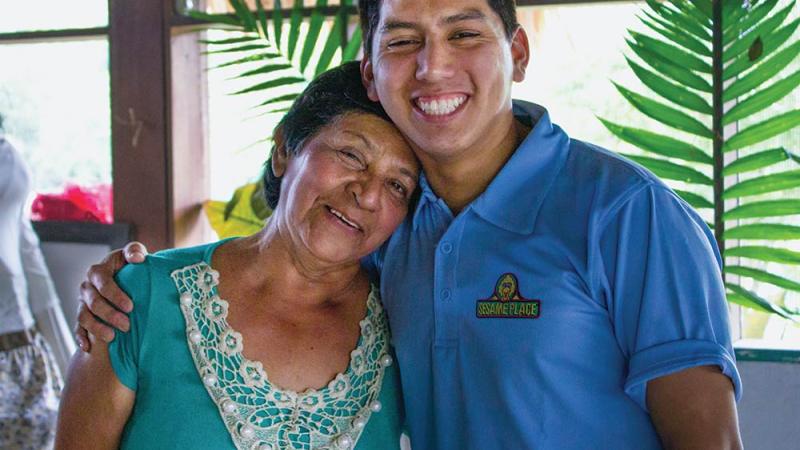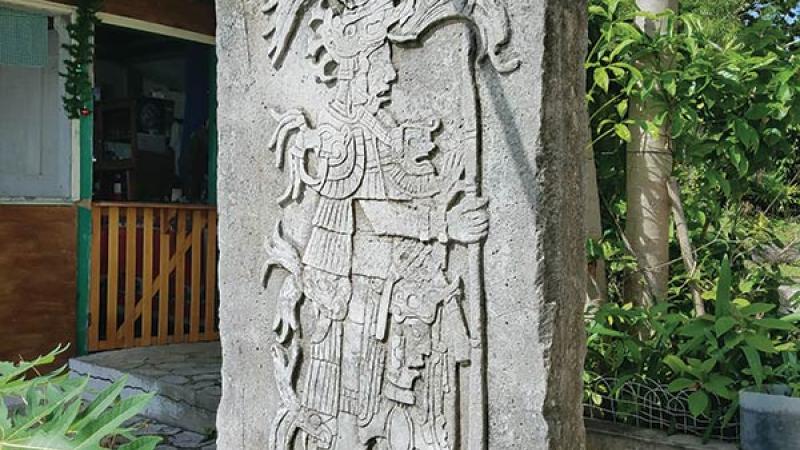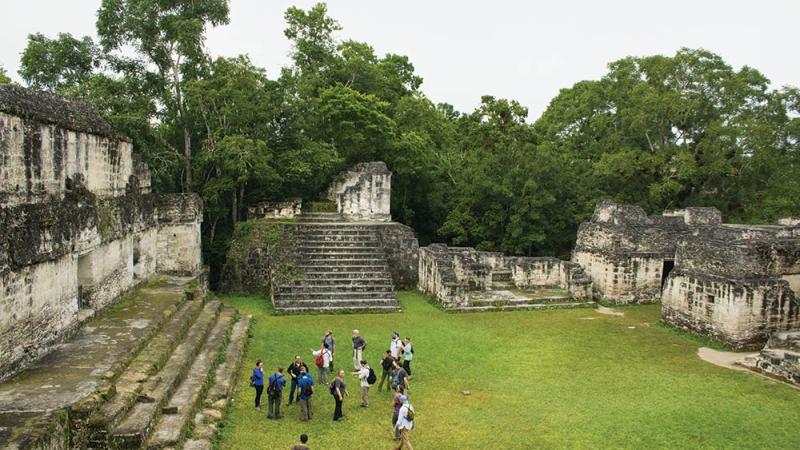Graphic design student Joey Morrin.
Self-Study
Published 07.29.2019
by Cindy Davis Meixel, writer/photo editor. Photos by Joey Morrin, except as credited
A one-credit study abroad trip is the reason Joey Morrin enrolled at Pennsylvania College of Technology.
The college was at the top of his list for graphic design studies, but his older brother was a Penn College student. Not wanting to follow his footsteps, Morrin was considering Drexel University instead. That was until he saw the course description for Mathematics in Non-European Cultures II.
Exploring Maya mathematics, design, engineering and astronomy, the class’s next study abroad trip would be to Guatemala: Morrin’s native country – a place he did not remember.
Born in December 1997 in Escuintla, a city in southwestern Guatemala on the Pacific coastal plain, Morrin arrived in the U.S. at 15 months of age, adopted by a Pennsylvania couple who had previously adopted another boy from Guatemala.
Growing up in Morrisville in Bucks County, Joey and his brother, Christopher, enjoyed quintessential U.S. childhoods, brimming with basketball, soccer, tennis and track. Their mother, a high school math teacher, was also a basketball and tennis coach, so an active lifestyle was part of the family equation.
IT ALLOWED ME TO GROW AND FEEL A BIT MORE WHOLE THAN EVER BEFORE.
Fully identifying as a North American kid, Joey had not given much thought to Guatemala – until college came calling.
“I always imagined that I would eventually find it some way, yet to my surprise, it found me because of Penn College,” he said. “Before the trip, I was not actively trying to visit Guatemala, but by chance, I found myself knee-deep in the opportunity of a lifetime.”
After completing a prerequisite course, Mathematics in Non-European Cultures I, in Fall 2017, Morrin joined 17 other travelers, including three faculty members, on a 10-day trip to Guatemala that commenced two days after Christmas and extended into the first week of 2018.
Key in Morrin’s mind was whether he’d feel at home in Guatemala. Although his parents had provided positive multicultural reinforcement, and diversity was common in his community and schools, there remained a subtle sense of “otherness” in his life in the U.S. Would his physical appearance, directly connecting him to his Central American roots and Maya Indian ancestors, translate into a sense of belonging in Guatemala?
“He wondered how that would play out when we reached Guatemala,” said one of his course instructors, D. Robert Cooley, associate professor of anthropology/environmental science. “Would he fit in or would he be an outsider there – fitting in by appearance, but not culturally?"
Some of his questions were answered on the group’s first flight.
“The flight crew on Avianca, a Colombian airline, addressed him initially in Spanish, apparently assuming he was returning to a Central American home from the U.S.,” Cooley said. “The surprise on their faces when they realized he spoke no Spanish was tangible, and at times, it seemed almost as if Joey would need to explain why to justify the situation.”
These types of exchanges continued throughout the trip as local Guatemalans perceived Morrin to be a tour guide or the “point person” for communication with the group. Some admonished him for not knowing Spanish. The ensuing confusion and frustration were difficult for the young traveler, who said he “learned to stay in the back” of the group to not call attention to himself.
He found “freedom” from the pressure by walking down a street by himself, taking photographs.
“I could absorb it all better without everyone around me. Without them drawing attention to me, I just looked like a tourist taking photos,” he said.
Older women, in particular, gravitated toward Morrin.
“They perceived me as ‘the lost child,’ finally coming back home,” he related. “They wanted to hug and comfort me, even though, for me, there was nothing to be comforted about.”
Hugging him warmly, one woman said (in Spanish), “You need to get Guatemala in your heart. Welcome home, son.”
In another encounter, an older man shook Morrin’s hand and welcomed him back to his ancestral homeland. Joseph E. LeBlanc, assistant professor of physics, who speaks fluent Spanish and traveled with the group, translated: “He says he’s very happy for you. You have a world of possibilities at your fingertips. Enjoy it.”
Although emotional and often challenging for Morrin, the exchanges enhanced the experience for many of his fellow travelers.
“One of the other students said to me, ‘I just loved walking with you. You didn’t know what was going to happen next!’” Morrin said.
The trip itself was filled with new experiences and surprises for the Penn College group. Although Cooley and co-instructor Curt E. Vander Vere, assistant professor of mathematics, began taking groups to Guatemala in 2011, an unexpected adventure landed in their path in 2018. They were invited to explore an enormous cave near the town of Flores. Cuevas del Tecolote had just been opened to the public by a local Maya co-op of families and landowners as a historical site, and the Penn College group was believed to be the first non-Maya tour group to view it. (The English translation of “tecolote” is “owl.”)
“When we arrived, a few local Maya families were seated around a hearth, reciting prayers as part of a New Year’s celebration,” Cooley said. “It was the same religious ceremony that the Maya had celebrated in that spot for centuries, according to our local guide. The students were speechless. Our guide showed us the residue of a painted owl on the cave walls and moved the flashlight to the cave floor where there were thousands and thousands of pottery shards and stone tool fragments. The objects were from very different time periods, and they correlated to things we saw in museums. It was like a time capsule of Maya history. The cave had been the place of continuous human activity for 2,000 years.
Morrin assembled a detailed journal with photos, pencil sketches and written entries created during his time in Guatemala. Remaining photos, provided by Morrin.
“Everyone was completely spellbound. I’ve never seen a group of students so captivated. It was such a powerful experience. What a neat thing we lucked into. The students felt very special it was shared with them.”
The group also visited Maya ruins at El Ceibal, Yaxha, Tikal and Uaxactun, and explored the Ixpanpajul Natural Park where they ziplined, hiked and traversed suspension bridges.
Morrin, ever the artist, captured these experiences with a camera and pencil sketches. Many were placed into a detailed journal. He also completed a required class project highlighting an educational aspect of the study abroad trip. For his part, Morrin conducted research, reaching out to other Guatemalan adoptees via a Facebook community page – Next Generation Guatemala – to further explore the topic of cultural identity. His final project was titled “Identity Defined.”
“In conducting my extensive post-trip research, I was overjoyed to find that I’m not the only adoptee who relates to a feeling of cultural limbo. It’s something only a very small and very special group of individuals can relate to,” Morrin said.
Prior to Joey’s return to Guatemala, his brother, Chris, held no interest in exploring his homeland, but he has enjoyed hearing about his brother’s explorations, and his curiosity has been stirred.
“I have a feeling that if I went back, he would join me after hearing me talk about the trip and seeing the photos I took,” Joey said. “I would love to return to Guatemala. If I were to go back, I would definitely learn a good amount of Spanish before returning so that I could interact with the locals and speak for myself rather than relying on others to be my voice.”
Joey continues to process his journey to Guatemala and his journey of self-identity.
“I greatly enjoyed learning about all things Maya. … The trip, the loving people, the mouth-watering food, and the unique culture I was immersed in were not only new to me, but were, in a way, very refreshing to experience,” he said. “For the first time, I looked like others around me; I was no longer ‘the brown kid’ or a complete anomaly. I was home, but in my heart, I was not.
“The disconnect between my American heart and my Guatemalan roots is one that I have embraced even more than before. I’ve become comfortable with fitting in loosely in the places where I don’t quite fit in. It’s not like a round hole with a square peg, but a round hole with a smaller round peg. I don’t fit snuggly, but I’m in there.”
He added: “It is something I will always hold close to my heart, because it allowed me to grow and feel a bit more whole than ever before.”








Share your comments
Penn College Magazine welcomes comments that are on topic and civil. Read our full disclaimer.
We love hearing from you